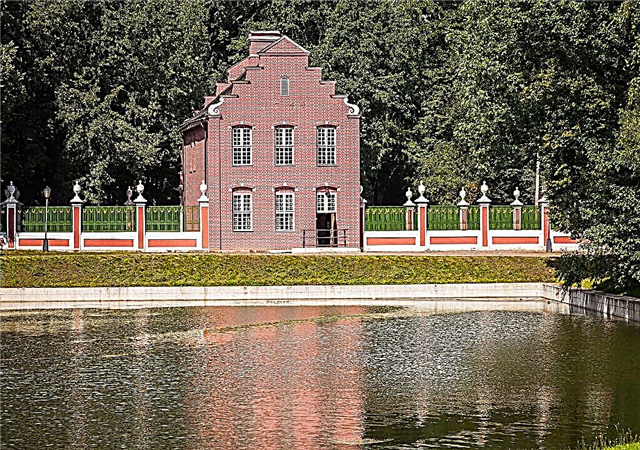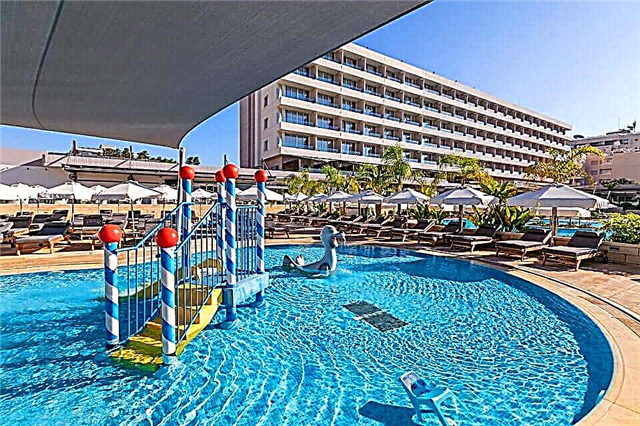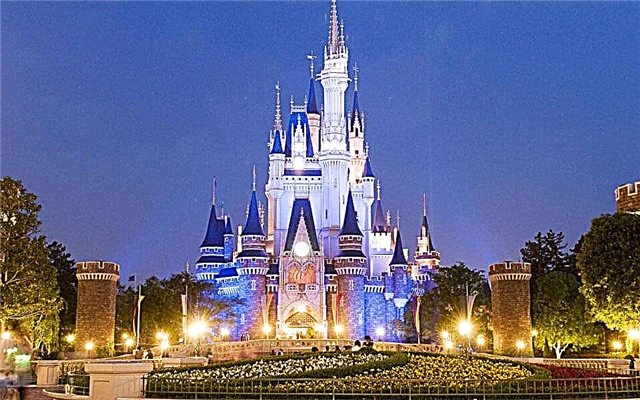The Kuskovo estate in Moscow is a magnificent example of architecture and landscape design of the 18th century. The architectural and park ensemble consists of several parts representing different European styles (English, French, Italian, Dutch). The center of the composition is the palace of the Sheremetyevs. It has preserved the ancient furnishings - furniture, decor items, works of art. There are 2 museums on the estate, attracting numerous visitors.
Construction history

Since ancient times, the Sheremetyev family owned the territory on which Kuskovo is located. The name of the residence was mentioned in the chronicle documents as early as the 16th century. According to records dating from the 20s of the 17th century. in Kuskovo there was a boyar estate surrounded by the dwellings of serfs. There was also a wooden church among the buildings. The name of the settlement came from the word "piece", since the land belonging to the Sheremetyevs was surrounded on all sides by the lands of the Cherkasskys. A.M. Cherkassky's daughter married Pyotr Borisovich Sheremetyev. As a dowry she got the land around Kuskovo. Thus, the estate became the center of a vast estate.
In the middle of the 18th century (1750-70) P. Sheremetyev decided to rebuild his residence and give it the features of the style called “Elizabethan Baroque”. To this end, it was planned to modify the external appearance of the palace, lay out a park, create artificial reservoirs, decorate the territory with various architectural forms and works of art. To create a project for the reconstruction of Kuskovo, serf master architects Alexei Mironov and Fyodor Argunov were involved. Under their leadership, the building of the palace was equipped (1774). A feature of its layout was the single-axis arrangement of the premises. All rooms stretched one after another, along a single line.
As conceived by the owner, Kuskovo was supposed to play the role of a suburban complex designed to receive and entertain guests. For this purpose, recreational areas (gazebos, pavilions, grottoes) and all kinds of attractions were created:
- Menagerie
- Greenhouse
- Kunstkamera
- Pond flotilla
At the same time, the residence could accommodate over 30 thousand people.
The last owner of Kuskovo was S.D. Sheremetyev. Immediately after the revolution of 1917, the estate was nationalized by the Soviet government and in 1919 acquired the status of a museum. At the end of the 30s. a collection of ceramics is located on its territory. Since then, both museums have coexisted together. In the early 60s. the area of the village of Veshnyaki, to which the Kuskovo estate belongs geographically, turned out to be within the boundaries of Moscow.
Architectural ensemble
Compositionally, the estate was divided into 3 parts:
- Palace surrounded by a French park
- Menagerie with artificial ponds
- English park
The building of the palace, otherwise called the Big House, was built according to the project of the architect K. Blank, a recognized master of the Baroque style. In its original form, the house was built of wood, which was covered from above with a layer of pale pink plaster. The facade was decorated with columns. Above them was the patrimonial emblem of the Sheremetyevs' counts. The porticoes on the sides were decorated with carvings in the form of all kinds of military accessories. The army decor was supposed to remind of the rank of field marshal Boris Petrovich Sheremetyev.
The house had 2 floors that perform their own functions:
- In the basement there were utility rooms, wine cellars, storerooms;
- The upper floor housed rooms for guests, halls for receptions and balls.
The palace is separated from the rest of the estate by the Big Pond. All sorts of small structures were erected on the Zaprudnaya territory. They were intended for the amusement of visitors. The buildings included:
- Greenhouses - Big Stone and American
- Aviary
- Menagerie
- Air theater
To serve the needs of the owners and guests, there was a kitchen in the outbuilding, a shed for carriages, and a dryer. In addition, a separate building was occupied by the manager. The estate had its own church equipped with a bell tower. A special group is formed by buildings located in the park area. Each of them represented a certain direction in architecture. The premises were used for receiving guests.
Big house

The Summer Palace was built according to the basic requirements of the classical style. It is characterized by the solemn decor of the premises, the use of numerous works of art (paintings, sculptures) as decorations. Comfortable conditions (plank floors, fireplaces, lighting fixtures) are combined with decorative elements (stucco, carving, painting).
Masters of various specialties - sculptors, painters, carvers - worked on the creation of the Big House. They were led by the talented architect Karl Ivanovich Blank, a representative of the Moscow architectural school. Thanks to the efforts of museum workers, the interiors of the Sheremetyevsky Palace in Kuskovo were preserved in their original form. In the late 70s and early 80s, a large-scale restoration was carried out. Visitors have a unique opportunity to touch the creations of the masters of the 18th century.
Italian house

An excellent example of southern European architecture is the pavilion called the Italian House. It was erected in the 50s of the 18th century. The famed diplomat and connoisseur of Western art Yuri Ivanovich Kologrivov acted as the direct curator of the construction. He spent many years traveling around Europe in search of rare things. Trained as an architect in Rome.
The project of the Italian house developed by Kologrivov provided for the arrangement of 2 floors:
- The 1st floor was intended to accommodate collectible exhibits (antique sculpture, models of temples in Bethlehem and Jerusalem, marble mosaics, bead paintings, etc.)
- 2nd floor was equipped for mass receptions
Dutch house

In contrast to the splendor of the Italian Pavilion, the Dutch House displays simplicity and modesty. Its decoration repeats the traditional look of the 17th century Dutch dwellings. The main decorative element is ceramic tiles, which were used to tiled the premises. Over 10 thousand tiles made in Delft and Rotterdam were used to decorate the building.
The interior decoration consists of a rich collection of porcelain items: figurines, dishes, vases, tulips. In addition, the pavilion houses the only collection of decoy figurines in Russia. A corner of Holland with a vegetable garden, a garden, and gazebos was recreated in front of the house. The building was built in 1749 and has remained unchanged to this day.
Pavilion "Grotto"

The arrangement of the Grotto on the territory of the estate was entrusted to the German master Johann Vocht. The process took over 10 years (1761 - 1775). The artificial structure was supposed to reproduce the interior of a real grotto as accurately as possible. For this purpose, natural materials were used: tuff of different shades (pink, yellow, white), shells.
The atmosphere of the underwater kingdom is imitated with the help of skillfully executed images of fish, molluscs, and marine life. Inside the grotto is divided into 3 parts:
- Northern Cabinet
- Southern Cabinet
- Central hall
The real highlight of the pavilion is clay and wood dolls decorated with shells. They were acquired by Count Sheremetyev in Europe at the end of the 18th century and are genuine rarities. To emphasize the connection of the Grotto with the water element, a pond with fish was arranged near it.
Hermitage Pavilion

For solitude and meditation, the Hermitage pavilion was created. In it, guests could hold meetings tete-a-tete.However, the Count made his Hermitage accessible only to a limited circle of close people. The small building had 2 floors. The servants were housed downstairs, food was being prepared. A special device for lifting food was equipped.
Manor parks decoration

The Kuskovo park zone is divided into several parts. They reflect the main features inherent in the landscape design of France and England. The only French park in Russia that has survived unchanged has existed for over 200 years. It is decorated with numerous sculptural compositions. There are flower beds everywhere. Rare ornamental plants were collected in greenhouses.
The pavilions scattered over the territory organically fit into the landscape - the Dutch and Italian House, the Hermitage, the Grotto. The English Guy is in many ways similar to the natural landscape, which is complemented by picturesque bridges and pavilions. Here is the House of Solitude, where the count's family lived. A menagerie with wild animals and an aviary were also set up.
The manor today

For almost 100 years, the Kuskov estate has had the status of a museum. This is a wonderful monument to the history and culture of the Russian people. Visitors can explore the interior interiors of the premises, walk along the paths of the park area, and visit the Museum of Ceramics. A greenhouse was used to place the expositions. It presents portraits of prominent personalities from the Sheremetyev family. The valuable collection of porcelain and ceramics is of great interest to the public.
The Kuskovo estate has become a set for popular films and TV series more than once. Filming took place on the territory of the estate:
- "Hello I'm your aunt!"
- "Vivat, midshipmen!"
- Shirley-Myrley
- "Secrets of palace coups"
Opening hours and ticket prices

You can visit the estate from Wednesday to Sunday. The museum is closed on Monday and Tuesday. In addition, a cleaning day is held every month on the last Wednesday. The Museum of Ceramics is open to the public from May to September. The Grotto Pavilion is currently under restoration.
The exact work schedule is presented on the official website of the Kuskovo Estate.
An object | Time to visit |
| Palace, Italian house, Dutch house | 10-16 hours |
| Hermitage, American greenhouse, Large stone greenhouse | 10-18 hours |
| Park zone | 10-18 hours |
The cost of entrance tickets to different objects is different There are preferential rates for pensioners and schoolchildren. Free for inpatient students.
Object for inspection | Adults | Pensioners and schoolchildren |
| Palace | 250 | 100 |
| Dutch house | 100 | 50 |
| Italian house | 100 | 50 |
| Hermitage | 150 | 50 |
| Large stone greenhouse | 150 | 100 |
| American greenhouse | 150 | 100 |
| entrance to the park | 50 | 50 |
Where is it and how to get there
Estate address - Moscow, st. Youth d. 2.
There are several ways to get there.
Metro:
- to st. "Ryazansky Prospect" and further by buses No. 133, 208
- to st. "Novogireevo", and then either by bus No. 64, or by trolleybus No. 77, or by shuttle bus to the stop. "Street of Youth". From there, walk to the park entrance (about 600m)
- to st. "Vykhino" with a change to the bus number 620 to the stop. "Museum Kuskovo"











